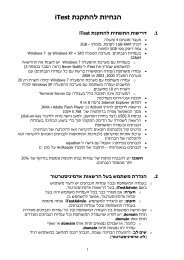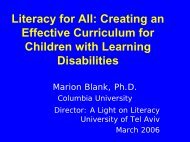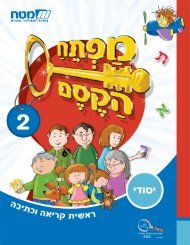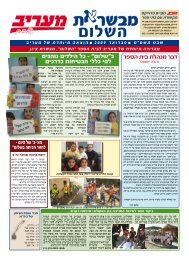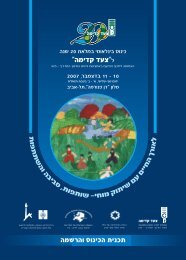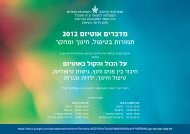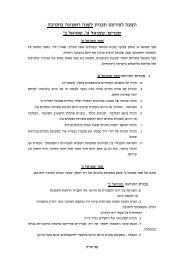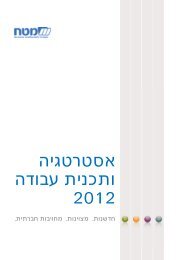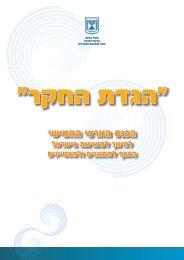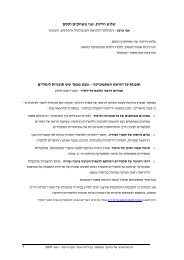Siblings, Peers, and Adults:
Siblings, Peers, and Adults:
Siblings, Peers, and Adults:
You also want an ePaper? Increase the reach of your titles
YUMPU automatically turns print PDFs into web optimized ePapers that Google loves.
TECSE 24:4 187–198 (2004) 187<br />
<strong>Siblings</strong>, <strong>Peers</strong>, <strong>and</strong> <strong>Adults</strong>:<br />
Differential Effects of Models for Children With Autism<br />
Christopher D. Jones<br />
Ilene S. Schwartz<br />
University of Washington<br />
Employing typically developing children <strong>and</strong> adults as models of appropriate behavior<br />
for children with autism <strong>and</strong> other developmental disabilities has been a<br />
common practice for more than four decades, <strong>and</strong> peer modeling serves as one of<br />
the theoretical cornerstones of inclusion <strong>and</strong> related innovations. In addition to examining<br />
adult <strong>and</strong> peer modeling, this study extends previous modeling research by including<br />
a subset of peers—siblings. The authors employed a parallel-treatments<br />
single-subject design counterbalanced across stimulus sets <strong>and</strong> replicated across three<br />
participants to extend previous research on the effectiveness of peers, siblings, <strong>and</strong> adults<br />
as models for teaching novel language skills to children with autism spectrum disorder.<br />
Participants learned the target skills under all three modeling conditions.<br />
In June of 2001, the National Research Council’s report<br />
on educating children with autism declared that an important,<br />
if not crucial, aspect of effective educational programs<br />
for children with autism spectrum disorder (ASD)<br />
is to provide as much intervention as possible in settings<br />
with typically developing, same-age peers (National Research<br />
Council, 2001). Although some educators proposed<br />
inclusive placements for children well before the<br />
passage of the Education for All H<strong>and</strong>icapped Children<br />
Act in 1975, inclusive education has become more commonplace<br />
in the last decade (U.S. Department of Education,<br />
2001). One primary benefit of inclusion cited by<br />
many families, researchers, <strong>and</strong> advocates is the increased<br />
opportunity for children with disabilities to observe <strong>and</strong><br />
learn from their typically developing peers. Despite the<br />
common belief that observational learning is a benefit of<br />
inclusive education, very little research examining how<br />
best to teach children with disabilities (specifically,<br />
autism) to become observational learners is available.<br />
For observational learning to occur, a child must<br />
first monitor the activities of a model <strong>and</strong> then reproduce<br />
the relevant <strong>and</strong> appropriate behavior of that model<br />
when presented with similar environmental contingencies.<br />
Garfinkle <strong>and</strong> Schwartz (2002) thus suggested that<br />
one prerequisite skill for all observational learning is imitation.<br />
The importance of learning through imitation is<br />
often acknowledged in everyday life <strong>and</strong> in the developmental<br />
literature (e.g., B<strong>and</strong>ura, 1986; Bijou & Baer,<br />
1961; Piaget, 1962; Schunk, 1987). Indeed, the idea that<br />
students with disabilities would imitate their peers <strong>and</strong><br />
acquire skills through observational learning was often<br />
cited as one of the initial arguments in favor of inclusion<br />
(Greenwood et al., 1987; Guralnick, 1976; Wolfensberger,<br />
1972). Evidence for inclusive practices therefore<br />
should include studies that examine imitation <strong>and</strong> modeling<br />
strategies that work for children with ASD <strong>and</strong><br />
other disabilities.<br />
Research has indicated that in most effective modeling<br />
programs for children with disabilities, four factors—<br />
attention to model, model competency, nature of the<br />
model/learner relationship, <strong>and</strong> length of the model/<br />
learner relationship—appear to be prevalent (B<strong>and</strong>ura,<br />
1977; Carr & Darcy, 1990; Peck, Cooke, & Apolloni,<br />
1981; Strain, Cooke, & Apolloni, 1976). Of these factors,<br />
attention to model <strong>and</strong> model competency have been<br />
the most commonly cited in the research literature (B<strong>and</strong>ura,<br />
1977; Carr & Darcy, 1990; Strain et al., 1976).<br />
This in turn suggests that the type of peer model used<br />
may play an important role in the effectiveness of a modeling<br />
intervention. Peck et al. (1981) postulated that the<br />
nature <strong>and</strong> length of the child’s social history will also facilitate<br />
effective imitation. As a result, the type of rela-<br />
Address: Christopher D. Jones, Box 351525, Department of Psychology, University of Washington, Seattle, WA 98195-1525;<br />
e-mail: cdj@u.washington.edu
188 Topics in Early Childhood Special Education 24:4<br />
tionship between the model <strong>and</strong> the learner could also<br />
play an important role in the effectiveness of a modeling<br />
intervention.<br />
PEER MODELING AND AUTISM<br />
The literature contains conflicting evidence regarding the<br />
effectiveness of using peer models as a method for teaching<br />
children with ASD. However, there is substantial<br />
evidence showing the positive effects of using typically<br />
developing children as models of appropriate behavior for<br />
children with ASD or developmental disabilities (Barry<br />
& Overmann, 1977; Egel, Richman, & Koegel, 1981;<br />
Garfinkle & Schwartz, 2002; Kohler, Strain, Hoyson, &<br />
Jamieson, 1997; Lanquetot, 1989). <strong>Peers</strong> have been used<br />
as exemplars for teaching behaviors such as language<br />
(Charlop, Schreibman, & Tryon, 1983), social play (Carr<br />
& Darcy, 1990; Peck, Apolloni, Cooke, & Raver, 1978),<br />
social interaction (Garfinkle & Schwartz, 2002), vocational<br />
skills (Sundel, 1994), <strong>and</strong> motor responses (Apolloni,<br />
Cooke, & Cooke, 1977).<br />
On the other h<strong>and</strong>, findings from different investigations<br />
have caused researchers to question the effectiveness<br />
of peer modeling as an instructional strategy for<br />
children with ASD. In these studies, the use of peer imitation<br />
<strong>and</strong> modeling to teach concrete or novel behaviors<br />
was sometimes inefficient (Ihrig & Wolchik, 1988) or<br />
unsuccessful (Charlop & Walsh, 1986). In addition, although<br />
in some studies peer models succeeded in teaching<br />
novel behaviors, additional prompting or adult intervention<br />
was necessary before the subjects provided any consistent<br />
imitative response (Blew, Schwartz, & Luce, 1985;<br />
Carr & Darcy, 1990; Peck et al., 1978). Some researchers<br />
thus have suggested that unless the peer model is to be<br />
used on multiple occasions to teach multiple students,<br />
this strategy may require too much valuable teacher time<br />
that could be better used for direct instruction (Young,<br />
1981).<br />
<strong>Siblings</strong> represent a special case of peer model that<br />
has received insufficient attention in the research literature.<br />
If one takes the four previously mentioned characteristics<br />
of an effective model (attention to model, model<br />
competence, nature of social history, length of social history)<br />
as a whole, it would appear that a sibling should<br />
make the ideal model. Because of longer <strong>and</strong> typically positive<br />
social histories, as well as more educational opportunities<br />
with siblings in the home environment, one might<br />
speculate that children with ASD st<strong>and</strong> to learn more<br />
from observing siblings’ behavior than from observing<br />
the behavior of peers or adults.<br />
Various aspects of the relationship between children<br />
with disabilities <strong>and</strong> their nondisabled siblings have been<br />
studied, although the majority of these studies focused<br />
on the following three areas:<br />
• the effect that a child with disabilities had<br />
on his or her typically developing sibling<br />
(Lobato, 1983, 1985),<br />
• the behavior of children with disabilities<br />
when interacting with their typically developing<br />
siblings (Koegel, Stiebel, & Koegel,<br />
1998), or<br />
• sibling correlates in etiological studies<br />
(Rutter, 2000).<br />
Unfortunately, few studies have directly examined the<br />
effect of a sibling model on the development of novel behaviors<br />
in children with ASD. The small number of studies<br />
that have been conducted demonstrated that sibling<br />
modeling <strong>and</strong> direct sibling-to-sibling instruction can be<br />
useful educational methods (James & Egel, 1986; Taylor,<br />
Levin, & Jasper, 1999). Taylor <strong>and</strong> colleagues used a video<br />
modeling procedure to increase the number of playrelated<br />
statements that two children with ASD made to<br />
their siblings. After viewing videotaped play interactions<br />
between their respective siblings <strong>and</strong> an adult, the target<br />
children made a higher number of play comments across<br />
three different play situations. Although these studies indicated<br />
that sibling modeling can be an effective modeling<br />
procedure, they were not able to distinguish exactly<br />
how effective sibling models can be because other types<br />
of modeling groups were not evaluated.<br />
The purpose of this study was to extend the research<br />
base on peer modeling with children with ASD by<br />
independently examining the effectiveness of peers, siblings,<br />
<strong>and</strong> adults as models for teaching novel language<br />
skills. We included two different child models to provide<br />
an initial view of the potential differential effectiveness<br />
of these models. To evaluate the three models, we measured<br />
the number of correct responses the target children<br />
gave to questions about previously modeled picture cards<br />
<strong>and</strong> maintenance of these newly taught language skills.<br />
METHOD<br />
Participants<br />
Three preschoolers with ASD were the primary participants<br />
in this study. Grouped with each of these primary<br />
participants were three models: one typically developing<br />
sibling model who attended the same school, one typically<br />
developing peer model, <strong>and</strong> one adult model (see<br />
Table 1). In this study, each set of four participants (target<br />
child with ASD, sibling model, peer model, <strong>and</strong><br />
adult model) is referred to as a group (see Note). The target<br />
children were between the ages of 45 months <strong>and</strong><br />
62 months <strong>and</strong> had been diagnosed with ASD by a pediatrician<br />
or clinical psychologist. All of the children<br />
attended an urban, university-based early childhood education<br />
preschool <strong>and</strong> kindergarten that integrates chil-
Modeling 189<br />
TABLE 1. Age <strong>and</strong> Gender of Participants <strong>and</strong> Order of Model Presentation by Group <strong>and</strong> Stimulus Set<br />
Adult role<br />
Group Target child Sibling Peer <strong>and</strong> gender Set & model presentation order<br />
1 45 mos 60 mos 48 mos Assistant teacher Set 1 (Actions): peer, sibling, adult<br />
female female male female Set 2 (Professions): sibling, adult, peer<br />
Set 3 (Opposites): adult, peer, sibling<br />
2 47 mos 60 mos 48 mos Head teacher Set 1 (Actions): peer, adult, sibling<br />
male female male female Set 2 (Professions): adult, sibling, peer<br />
Set 3 (Opposites): sibling, peer, adult<br />
3 62 mos 42 mos 48 mos Head teacher Set 1 (Actions): peer, sibling, adult<br />
female female female female Set 2 (Professions): sibling, adult, peer<br />
dren with disabilities with same-age typically developing<br />
peers. The target children were selected on the basis of<br />
the availability of a sibling attending the same school,<br />
previous demonstration of adequate verbal imitation,<br />
<strong>and</strong> one-word expressive communication abilities. <strong>Peers</strong><br />
were identified from teacher suggestions about children<br />
with whom the target child spent the majority of time.<br />
<strong>Adults</strong> were selected based on their previous experiences<br />
in teaching the target child (> 6 months).<br />
Group 1. This group consisted of Target Child 1,<br />
Sibling 1, Peer 1, <strong>and</strong> Adult 1. Target Child 1 (Erin) was<br />
a 45-month-old White girl who had been diagnosed with<br />
ASD 9 months earlier. She typically communicated using<br />
one-word responses to questions but, according to teacher<br />
reports, rarely initiated communication. Although Erin<br />
often displayed numerous behaviors associated with ASD<br />
(i.e., social withdrawal, stereotypies), she was making<br />
progress in several domains targeted by her Individualized<br />
Education Program (IEP). During the school year<br />
she acquired a relatively large functional vocabulary (approximately<br />
200–300 words), increased her social interactions<br />
with peers, <strong>and</strong> increased her attention skills.<br />
Sibling 1 was a 5-year-old typically developing girl<br />
who was in the same inclusive classroom as her younger<br />
sister. Sibling 1 showed appropriate language skills for<br />
her age, <strong>and</strong> both her mother <strong>and</strong> teachers reported that<br />
she had a positive relationship with her sister. Peer 1 was<br />
a 4-year-old typically developing boy who attended the<br />
same classroom as Erin. He was identified by the classroom<br />
teacher as a good friend of Erin’s with whom she<br />
often spent time in the classroom. Adult 1 was the assistant<br />
teacher in Erin’s classroom. This teacher had more<br />
than 9 months’ experience working with Erin in the<br />
classroom <strong>and</strong> described her relationship with Erin as<br />
very positive.<br />
Group 2. This group consisted of Target Child 2,<br />
Sibling 2, Peer 2, <strong>and</strong> Adult 2. Target Child 2 (Jerry) was<br />
a 47-month-old White boy who had been diagnosed with<br />
ASD at 24 months. Jerry was able to express himself using<br />
short sentences <strong>and</strong> was working in therapy sessions<br />
on exp<strong>and</strong>ing his communication abilities. Although Jerry<br />
rarely initiated interactions (except to request preferred<br />
items or activities), he maintained a large functional vocabulary.<br />
In addition, he had made remarkable progress<br />
in the preschool program, especially in the area of peer<br />
social interactions.<br />
Sibling 2 was a 5-year-old White girl who attended<br />
an inclusive kindergarten classroom in the same school<br />
as her brother. She had language skills that were developmentally<br />
appropriate for her age, <strong>and</strong> she indicated that<br />
she had a positive relationship with her younger brother.<br />
Peer 2 was a 4-year-old typically developing boy who attended<br />
the same classroom as Jerry. Peer 2 was identified<br />
by the classroom teacher as one of the children with whom<br />
Jerry spent most of his time. Adult 2 was Jerry’s classroom<br />
head teacher. She had worked with Jerry for 6 months<br />
<strong>and</strong>, according to Jerry’s mother, was one of the primary<br />
influences on his dramatic increase in social skills.<br />
Group 3. This group consisted of Target Child 3,<br />
Sibling 3, Peer 3, <strong>and</strong> Adult 3. Target Child 3 (Jennifer)<br />
was a 62-month-old White girl who had been diagnosed<br />
with ASD at 24 months. Jennifer communicated with peers<br />
<strong>and</strong> adults when approached, but she used one- <strong>and</strong> twoword<br />
phrases during these interactions. According to her<br />
mother, Jennifer maintained a large functional vocabulary<br />
<strong>and</strong> communicated in complete sentences but would<br />
often revert to short, simple phrases <strong>and</strong> words (such as<br />
common labels <strong>and</strong> actions) when approached by other<br />
children. She maintained frequent social interactions with<br />
her peers during play, although these interactions typically<br />
consisted of requests <strong>and</strong> dem<strong>and</strong>s by Jennifer.<br />
Sibling 3 was a 3 1 ⁄2-year-old White girl who attended<br />
a preschool classroom down the hallway from Jennifer.<br />
She was described by her teacher as having typically developing<br />
cognitive, social, <strong>and</strong> language skills that were<br />
appropriate for her age. Jennifer’s mother also described<br />
the sibling relationship as positive although incredibly
190 Topics in Early Childhood Special Education 24:4<br />
competitive. Peer 3 was a 4-year-old typically developing<br />
girl who attended the same classroom as Jennifer. Peer 3<br />
was identified by her classroom teacher as one of two<br />
children with whom Jennifer spent the majority of her<br />
time. Although both Sibling 3 <strong>and</strong> Peer 3 were quite<br />
younger than Jennifer, both were described by the head<br />
teacher as “well ahead” of Jennifer in their respective language<br />
comprehension <strong>and</strong> expression skills. Adult 3 was<br />
Jennifer’s classroom head teacher. She had been Jennifer’s<br />
teacher for more than 18 months <strong>and</strong> felt that she “understood”<br />
Jennifer quite well.<br />
Setting <strong>and</strong> Materials<br />
All of the baseline <strong>and</strong> experimental sessions took place<br />
in the hallway immediately outside of the target child’s<br />
classroom. The hallway was largely unpopulated during<br />
testing sessions, <strong>and</strong> distractions were kept to a minimum.<br />
Sessions were conducted at a 1 m × 1m child-size table<br />
where the participant sat facing a brick wall <strong>and</strong> thus<br />
had little visual stimulation. All study sessions were conducted<br />
during scheduled free-play time. For study sessions,<br />
the experimenter invited the children to come outside the<br />
classroom to do “special work.”<br />
Study materials consisted of 4" × 6" laminated picture<br />
cards. Various pictures from three categories (actions,<br />
opposites, professions) were presented to the target child<br />
to develop a core set of cards that could not be labeled<br />
correctly by the child (see the prebaseline procedures).<br />
Table 2 describes the specific stimuli used for each target<br />
child. All of these pictures were presented on a plain<br />
white background to avoid distracters in the pictures that<br />
might act as unintentional discriminative stimuli. Pictures<br />
were taken from the Picture This ® computer software,<br />
printed using a color printer, <strong>and</strong> then laminated.<br />
Experimental Design<br />
In this study, we used a parallel-treatments design (PTD)<br />
replicated across three stimulus sets (two sets for Jennifer).<br />
A PTD counterbalanced across stimulus sets was<br />
used because it has been described as the best method for<br />
examining the effectiveness of more than one instructional<br />
procedure on the acquisition of independent but<br />
comparable skills (Gast & Wolery, 1988). In addition,<br />
Gast <strong>and</strong> Wolery noted that the PTD is more useful than<br />
other designs for independently examining the effectiveness<br />
of instructional procedures on the acquisition of novel<br />
skills. An additional maintenance phase was included for<br />
follow-up examination of the newly learned skills.<br />
The initial order of models to which each target<br />
child was exposed was determined r<strong>and</strong>omly across children.<br />
This order of models remained consistent throughout<br />
the initial stimulus set. In subsequent sets, the order<br />
was again determined r<strong>and</strong>omly (albeit with the first order<br />
removed from the possible combinations), <strong>and</strong> that<br />
order remained consistent throughout that stimulus set.<br />
Finally, this r<strong>and</strong>omization of model order was again<br />
performed for a third stimulus set. The order of models<br />
for each stimulus set across each target child is shown in<br />
Table 1. This r<strong>and</strong>omization of model order across stimulus<br />
sets <strong>and</strong> the replication across target children were<br />
done to alleviate possible sequencing effects that might<br />
result from exposure to multiple interventions.<br />
An added advantage of the PTD is that similar to a<br />
multiple probe design, it does not require continuous<br />
baseline data collection for behaviors that have yet to be<br />
introduced to the design. Hence, the problem of excessively<br />
long testing sessions <strong>and</strong> extended practice of incorrect<br />
responding that can occur in a multiple baseline<br />
design is alleviated. Researchers conducting previous<br />
studies have had success using a PTD to independently examine<br />
individual interventions on comparable but independent<br />
behaviors (Boulware, 2001; Gast & Wolery,<br />
1988; Schloss, Alper, Young, & Arnold-Reid, 1995). For<br />
example, Schloss et al. examined two methods for teaching<br />
the acquisition of functional sight words to three<br />
adolescents with disabilities.<br />
The visual representation of data in this study looks<br />
similar to a multiple baseline design across three stimulus<br />
sets <strong>and</strong> replicated across three models within each<br />
set. What differentiates this study from a true multiple<br />
baseline design is the fact that each target child was exposed<br />
to all three interventions (i.e., models) on the same<br />
day <strong>and</strong> in the same order each day throughout an entire<br />
phase (i.e., stimulus set). In a true multiple baseline design,<br />
the target child is only exposed to one intervention<br />
(model) during each phase of the study.<br />
Procedure<br />
Prebaseline. The goal of the prebaseline sessions<br />
was to identify 27 test stimuli (i.e., stimuli that the target<br />
child could not accurately label) for each child. These selected<br />
stimuli were used during baseline <strong>and</strong> then r<strong>and</strong>omly<br />
assigned to each model during the intervention<br />
phase. For each of three stimulus classes (actions, professions,<br />
opposites), the target child was shown a picture<br />
<strong>and</strong> given a class-specific prompt:<br />
• “What is this person doing?” (Actions)<br />
• “Who is this person?” (Professions)<br />
• “If this is (e.g., open), then this is_______?”<br />
(Opposites)<br />
The target children were given the opportunity to respond<br />
to questions about the pictures during 81 different<br />
trials in each prebaseline session (each of the 27 different<br />
responses was assessed three times per session). After each<br />
question prompt <strong>and</strong> picture presentation, the partici-
Modeling 191<br />
TABLE 2. Specific Picture Stimuli Used for Each Target Participant<br />
Target child<br />
Picture stimuli<br />
1 Actions: diving, hiding, crawling, marching, pointing, digging, waving, throwing, skating<br />
Professions: fisherman, mechanic, archer, pilot, baker, farmer, dentist, plumber, lifeguard<br />
Opposites: apart/together, frozen/melted, rough/smooth, open/closed, same/different, front/back, empty/full,<br />
heavy/light, skinny/fat<br />
2 Actions: pointing, diving, hiding, digging, crawling, waving, marching, chopping, skating<br />
Professions: fisherman, mechanic, archer, pilot, baker, farmer, cashier, dentist, plumber<br />
Opposites: apart/together, frozen/melted, rough/smooth, open/closed, same/different, front/back, empty/full,<br />
heavy/light, skinny/fat<br />
3 Actions: diving, hiding, digging, waving, marching, chopping, blowing, throwing, skating<br />
Professions: soldier, dentist, waitress, lifeguard, plumber, archer, pilot, baker, farmer<br />
pants were given 5 s to respond. Correctly identified pictures<br />
were discarded <strong>and</strong> new pictures were substituted.<br />
The lead author conducted all experimental sessions—<br />
prebaseline, baseline, intervention, <strong>and</strong> maintenance—<br />
during short free-play periods to avoid pulling the target<br />
child from structured instruction time in the classroom.<br />
Baseline. Similar to the prebaseline sessions, baseline<br />
sessions were conducted with the target child <strong>and</strong><br />
experimenter only. In addition to establishing an initial<br />
zero-level baseline across all three response classes on at<br />
least 2 successive days, 1 or 2 additional baseline data<br />
points were taken 1 day prior to each intervention phase<br />
to ensure baseline stability <strong>and</strong> no carryover effect from<br />
one intervention phase to another. For a more detailed<br />
explanation of the rationale behind baseline data collection<br />
in the multiple probe design (<strong>and</strong>, consequently, the<br />
PTD) see Gast, Skouge, <strong>and</strong> Tawney (1984) or Gast <strong>and</strong><br />
Wolery (1988).<br />
Training for Sibling, Peer, <strong>and</strong> Adult Models. After<br />
agreeing to participate in the study, the siblings <strong>and</strong> peers<br />
were told that they would be acting as “special teachers”<br />
for the identified target child. Each sibling, peer, <strong>and</strong><br />
adult model was trained with direct instruction to respond<br />
appropriately by correctly labeling the target stimulus<br />
following a verbal prompt by the experimenter. No<br />
other instructions were provided to the models about<br />
how to interact with the target children during testing<br />
sessions.<br />
Modeling Intervention. During intervention sessions,<br />
the models were instructed to respond appropriately to<br />
each of the experimenter’s questions according to how<br />
they had been trained. The order of the models was assigned<br />
r<strong>and</strong>omly across each phase of the study but remained<br />
consistent within each phase/stimuli set. For<br />
example, during the Actions set for Erin, the order of<br />
models was consistently peer, sibling, adult; however, a<br />
different r<strong>and</strong>om ordering occurred during the other two<br />
phases (Professions, Opposites). During modeling sessions,<br />
the experimenter prompted the model by showing<br />
a picture card <strong>and</strong> asking a question about the picture, as<br />
described in the prebaseline section. After the correct<br />
model response, the experimenter provided verbal feedback<br />
to the model (e.g., “That’s correct”), then gave the<br />
same visual <strong>and</strong> verbal prompt to the target child <strong>and</strong><br />
waited 5 s for a response.<br />
If a target child responded correctly, the experimenter<br />
responded by saying, “That’s right,” recorded his<br />
or her answer, <strong>and</strong> continued with the next stimulus. If<br />
the target child responded incorrectly, the experimenter<br />
recorded his or her answer, remained silent, <strong>and</strong> moved<br />
on to the next stimulus. Because all of the models responded<br />
correctly during 100% of the intervention sessions,<br />
an error correction procedure was not required.<br />
After nine trials with one model (three trials for<br />
each of three stimuli), the experimenter, the target child,<br />
<strong>and</strong> the model went back to the classroom. The experimenter<br />
<strong>and</strong> the target child then returned to the setting<br />
with one of the remaining models <strong>and</strong> repeated the<br />
process with different stimuli from the same stimulus class<br />
(e.g., more Actions or more Professions). The same modeling<br />
procedure was used for each model, <strong>and</strong> sessions<br />
lasted approximately 5 min per model. Altogether, each<br />
session required approximately 15 min per day.<br />
The target children remained cooperative for the majority<br />
of sessions. The experimenter occasionally did need<br />
to redirect a target child’s attention back to the current<br />
session, but no sessions required further intervention due<br />
to excessively difficult or inappropriate behavior.<br />
A criterion level for successful completion of a stimulus<br />
set with a particular model was achieved when a target<br />
child responded correctly to 66% of the target stimuli<br />
(six out of nine pictures were labeled correctly). Intervention<br />
for each phase/stimulus set lasted at least three
192 Topics in Early Childhood Special Education 24:4<br />
sessions <strong>and</strong> until the target child reached criterion with<br />
at least two models. The number of intervention sessions<br />
was kept to a minimum, <strong>and</strong> the criterion level was set<br />
modestly low to avoid training incorrect responses in the<br />
target child over repeated sessions. Hence, if a target<br />
child did not appear to be changing his or her incorrect<br />
responses when responding to a particular model, we did<br />
not want the child to overpractice incorrect responding.<br />
Maintenance. Maintenance effects were measured<br />
for each target child in a manner similar to that used for<br />
the baseline procedures. The target children were assessed<br />
individually <strong>and</strong> without other models in the environment.<br />
Maintenance measures were taken from 1 day to<br />
2 weeks after conclusion of the intervention, according<br />
to what the classroom <strong>and</strong> school schedule would allow.<br />
Data Collection. All baseline, intervention, <strong>and</strong><br />
maintenance trials were scored as correct or incorrect.<br />
All responses that occurred within 5 s of a prompt <strong>and</strong><br />
included the correct noun or verb were scored as correct,<br />
regardless of utterance length or structure. In addition,<br />
correct articulation of the label was not necessary to<br />
score the attempt as correct as long as the participant<br />
was able to articulate the root of the label (e.g., run instead<br />
of running).<br />
Analysis. To assess the initial effectiveness of a particular<br />
model, we examined whether the target child<br />
reached criterion on that stimulus set with that model.<br />
Further effectiveness was considered through examination<br />
of the overall level of correct responses with each<br />
model during the intervention <strong>and</strong> maintenance phases.<br />
To ensure procedural integrity, a testing protocol was<br />
followed during each testing session. Procedural reliability<br />
data were not collected, however, due to the relative<br />
simplicity of experimenter behavior during each session.<br />
Regardless, settings, materials, verbal instructions, <strong>and</strong><br />
procedures were held as consistent as possible across all<br />
sessions <strong>and</strong> participants.<br />
Interrater Reliability. During baseline <strong>and</strong> each phase<br />
of the intervention, the first author recorded occurrence<br />
<strong>and</strong> nonoccurrence of target responses. Interrater reliability<br />
checks were conducted across all modeling conditions<br />
in approximately 21% (8 out of 39) of the sessions<br />
<strong>and</strong> no less than once per treatment phase across each<br />
stimulus set. During these sessions, an independent<br />
doctoral-level graduate student who had no knowledge<br />
of the experimental purposes recorded the target child’s<br />
responses (correct or incorrect) <strong>and</strong> compared her observations<br />
at the conclusion of the sessions. Reliability estimates<br />
were calculated using a point-by-point agreement<br />
ratio. Average reliability was 97% (range = 95%–100%)<br />
across children, <strong>and</strong> agreement never fell below 95%.<br />
Modeling<br />
RESULTS<br />
The results for each of the target children can be seen in<br />
Figures 1 through 3. All of the target children quickly responded<br />
to the implementation of modeling across all<br />
stimulus sets <strong>and</strong> across almost all models. That is, the<br />
children learned the target behaviors when, <strong>and</strong> only<br />
when, the modeling intervention was introduced. Overall,<br />
of the 24 sets of stimuli that were introduced (9 for<br />
Erin, 9 for Jerry, 6 for Jennifer), the target children met<br />
criterion on 22 sets in a relatively short interval (at most,<br />
4 days).<br />
Although the target children responded positively to<br />
modeling, a clear preference for one particular model<br />
across or within all target children was not seen. Only<br />
Jennifer responded correctly more often in the sibling<br />
modeling condition across both stimulus sets in which she<br />
was tested. However, neither Jerry’s nor Erin’s data indicated<br />
a clear differential effectiveness of one model across<br />
the three stimulus sets. Although a clear distinction among<br />
the models for effectiveness was not found, in six of the<br />
eight stimulus sets, overall correct responding in one of<br />
the child modeling conditions (either sibling or peer) was<br />
nearly equal to or higher than correct responding in the<br />
adult modeling condition.<br />
All of the target children reached the criterion level<br />
(correct responses to at least six of nine picture cards)<br />
with both sibling <strong>and</strong> peer models across all stimulus<br />
sets. In the adult modeling condition, Erin reached criterion<br />
on all sets, but Jerry did not reach criterion in the<br />
Opposites set <strong>and</strong> Jennifer did not reach criterion in the<br />
Professions set.<br />
Maintenance<br />
When removal of the models occurred during each phase<br />
<strong>and</strong> the target children were tested on each of the three<br />
stimulus sets again, Erin <strong>and</strong> Jerry were able to correctly<br />
label the picture cards at least 66% of the time. Interestingly,<br />
this includes one set of stimuli for which Jerry<br />
did not reach criterion during intervention. Maintenance<br />
of learned responses was also seen with Jennifer for the<br />
Actions stimulus set. The high response scores on maintenance<br />
probes up to 2 weeks after intervention suggest<br />
that the learned responses were maintained. Unfortunately,<br />
continued maintenance data collection for Jennifer,<br />
as well as data for the third set of stimuli, was<br />
discontinued because the school year ended.<br />
DISCUSSION<br />
This investigation examined the effectiveness of three<br />
different types of models on the acquisition of language
FIGURE 1. Frequency of correct responses for Erin during the baseline, peer modeling, <strong>and</strong><br />
maintenance phases.<br />
193
FIGURE 2. Frequency of correct responses for Jerry during the baseline, modeling, <strong>and</strong> maintenance<br />
phases.<br />
194
Modeling 195<br />
FIGURE 3. Frequency of correct responses for Jennifer during the baseline, modeling,<br />
<strong>and</strong> maintenance phases.<br />
skills in three children with ASD. The results of this<br />
study extend the evidence base concerning the efficacy of<br />
modeling as an instructional strategy to teach novel skills<br />
to children with ASD. In addition, this study provides<br />
more evidence in support of child modeling as a potentially<br />
effective educational strategy to use with children<br />
with ASD in inclusive environments.<br />
All three target children responded quickly <strong>and</strong> positively<br />
when exposed to each model (adult <strong>and</strong> child) of<br />
appropriate behavior, as compared to baseline. Across all<br />
three target children, correct responding increased immediately<br />
with the implementation of modeling. Although<br />
there was no consistent pattern across the target children,<br />
child models were at least as effective, <strong>and</strong> often<br />
more effective, than the adult models across all of the target<br />
children.<br />
Previous studies have had varying success using children<br />
as imitation models of appropriate behavior to<br />
teach new skills. Although imitation of adult models is a<br />
typical strategy in young children’s repertoires, for observational<br />
learning to be a positive side effect of inclusive<br />
education, children with disabilities must learn to<br />
imitate other children. Hence, in addition to examining<br />
adults as models, our study investigated the use of typically<br />
developing children as imitation models. Adult models<br />
were included in this study as an additional source of<br />
independent examination.<br />
In some cases, child modeling has been criticized as<br />
a teaching strategy that may require too many outside resources<br />
or too much teacher time to completely train <strong>and</strong><br />
employ individual models for effective use in educational<br />
settings (Young, 1981). Nonetheless, proponents of inclu-
196 Topics in Early Childhood Special Education 24:4<br />
sion feel that the potential benefits of child modeling<br />
outweigh these costs <strong>and</strong> further emphasize that social<br />
benefits, such as increased peer interaction, justify the necessity<br />
of using additional peer modeling strategies. The<br />
results of this modeling study strengthen the case that<br />
peers can serve as good models without extensive training<br />
(Garfinkle & Schwartz, 2002).<br />
Although we did not systematically examine each<br />
of the four characteristics—attention to model, model<br />
competence, nature of the relationship, <strong>and</strong> length of the<br />
relationship—most often associated with model effectiveness,<br />
according to parent reports, all of these sibling–<br />
target child dyads enjoyed long, positive relationships <strong>and</strong><br />
were competent in the modeling task. If the four characteristics<br />
are an exhaustive list of characteristics needed<br />
for a good model for a child with ASD, one would expect<br />
that the sibling model condition would have been the<br />
most effective. However, although the target children did<br />
learn in this condition, it was not more effective than the<br />
other conditions. This leads to two possible conclusions:<br />
1. There are additional characteristics of<br />
effective modeling that were not included<br />
in the original description.<br />
2. The inference that siblings make the best<br />
fit with the four characteristics is flawed.<br />
We believe that a combination of these explanations is<br />
probable.<br />
An additional contribution to effective modeling programs<br />
may be provided by two factors: motivation on<br />
the part of both model <strong>and</strong> target child to participate/<br />
engage in the exercise <strong>and</strong> overall satisfaction with the<br />
activity. Both of these socially based characteristics were<br />
observed by the first author as potential influential factors<br />
that may have facilitated correct responding in the<br />
target children <strong>and</strong> models. For example, the increased<br />
effectiveness of the peer model for Erin with the Opposites<br />
stimuli appeared to coincide with the model’s increased<br />
interest in <strong>and</strong> enjoyment of the activity (possibly<br />
a consequence of this child developing a better underst<strong>and</strong>ing<br />
of his role). In contrast, Erin’s sibling appeared<br />
almost bored with the task at the same point in the study,<br />
<strong>and</strong> her effectiveness consequently decreased. Unfortunately,<br />
systematic data collection on these characteristics<br />
as either primary or secondary factors was not included<br />
in the initial study design. The influence of these factors<br />
thus is mere conjecture at this point. Further investigations<br />
that examine their validity as potential mediating<br />
factors are necessary.<br />
What is unclear from the results of this study is a<br />
comprehensive identification of additional model characteristics<br />
for predicting effective skill acquisition. It appears<br />
that focusing solely on the formal model–learner<br />
relationship may be too narrow a perspective. Rather, the<br />
examination of variables specific to the observational<br />
learning context <strong>and</strong> to the modeling relationship may be<br />
a more effective means of predicting individual differences<br />
in children’s success with different models. In other<br />
words, a sibling may not always be the ideal model. A<br />
preferred classmate during circle time or favorite cousin<br />
at the zoo might just be better in those particular instances.<br />
Underst<strong>and</strong>ing what makes an effective model<br />
<strong>and</strong> whether characteristics of models change across time<br />
<strong>and</strong> settings requires further research. Perhaps there are<br />
effective methods for assessing model preference that are<br />
similar in structure to those we already use to assess reinforcer<br />
preference (Fisher et al., 1992; Paclawskyj & Vollmer,<br />
1995).<br />
In a typical reinforcer assessment for children with<br />
disabilities, we expose the child to multiple types of potential<br />
reinforcers in a noncontingent process. To begin,<br />
we identify nine potential positive reinforcers. We then<br />
allow the child to have access to three of these items (e.g.,<br />
blocks, a toy train, a squishy toy) <strong>and</strong> observe which item<br />
he or she chooses. After the child makes a choice, we give<br />
her or him the opportunity to play with that item for a<br />
brief time. The process is then repeated with the second<br />
<strong>and</strong> third sets of three items. The three preferred items,<br />
that is, the one in each set chosen by the child, are presented<br />
to determine which is the most preferred at that<br />
moment. This strategy assumes that children’s preferences<br />
<strong>and</strong> the reinforcing properties of different stimuli change<br />
frequently. Perhaps similar methods could be used to assess<br />
for model preference. A teacher could observe the<br />
child’s imitative behavior with a selection of different<br />
children in structured classroom situations to determine<br />
who might be a more effective model. However, as with<br />
reinforcer assessments, it is possible that the individual a<br />
child finds most rewarding <strong>and</strong> would like to work with<br />
may also fluctuate over time. The effectiveness of one<br />
particular child as a model may be much different on a<br />
subsequent day or even a different time of day. Obviously,<br />
more research is needed to determine the validity<br />
of this process.<br />
Some issues must be taken into consideration when<br />
evaluating the results of this study. First, the age discrepancies<br />
between the target children <strong>and</strong> their peer <strong>and</strong> sibling<br />
models, as well as among the models, were not held<br />
constant across the three groups. For two of the target<br />
children, the peer model was notably younger (by 1 year)<br />
than the sibling model, whereas in the third grouping,<br />
the peer model was actually older than the sibling model.<br />
It is possible that age was a contributing factor to the<br />
effectiveness <strong>and</strong> efficiency of a particular model. For example,<br />
Jennifer was more than a year older than her<br />
typically developing sister, to whom she responded most<br />
effectively.<br />
In addition to these age discrepancies, gender of<br />
model <strong>and</strong> target child was not held constant among the
Modeling 197<br />
three groups. One of the realities of conducting research<br />
within a school environment is that these factors cannot<br />
always be controlled. Because there was not an abundance<br />
of sibling pairs attending the same early childhood<br />
school together, we had to use the few sibling pairs that<br />
were available. The differences in these pairs did not allow<br />
us to control for all possible variables that might<br />
have contributed to variance in the target children’s labeling<br />
behaviors.<br />
One potential avenue for future research is to look<br />
for skill transfer into the classroom. The structured environment<br />
<strong>and</strong> stimulus presentation of this study allowed<br />
for more control over potentially confounding factors,<br />
such as noisy classroom distractions <strong>and</strong> interruptions.<br />
Because data on generalization were not collected, however,<br />
the question of whether skills learned from models<br />
will carry over into the classroom cannot be answered<br />
here. A measure of generalization would add to the<br />
strength of future studies in this area because the contingencies<br />
that governed the correct responding in the hallway<br />
could differ considerably from those that govern<br />
correct responding in the classroom.<br />
Although we did not systematically measure generalization<br />
to the classroom, their teachers reported several<br />
instances of the target children using their new vocabulary.<br />
For example, Erin’s teacher reported that Erin was<br />
observed crouching underneath the table during snack<br />
time. When asked what she was doing, Erin replied, “hiding,”<br />
as portrayed in the picture card that she learned.<br />
The results from this study should be useful to teachers<br />
<strong>and</strong> staff in special education classrooms. Educators<br />
must underst<strong>and</strong> that when the possibility exists for using<br />
a sibling or peer as a potential model for teaching<br />
skills to children with ASD, he or she may be just as effective<br />
(if not more so) than exhausting the much-needed<br />
resources of the teacher or paraprofessional. ◆<br />
NOTE<br />
Although each set of four participants is referred to as a group in this<br />
study, we do not want to indicate that the design of this study is in any<br />
way a traditional group design. This is a single-subject design study<br />
replicated across three children.<br />
REFERENCES<br />
Apolloni, T., Cooke, S. A., & Cooke, T. P. (1977). Establishing a normal<br />
peer as a behavioral model for developmentally delayed toddlers.<br />
Perceptual <strong>and</strong> Motor Skills, 44, 231–241.<br />
B<strong>and</strong>ura, A. (1977). Social learning theory. Englewood Cliffs, NJ:<br />
Prentice Hall.<br />
B<strong>and</strong>ura, A. (1986). Social foundations of thought <strong>and</strong> action: A social<br />
cognitive theory. Englewood Cliffs, NJ: Prentice Hall.<br />
Barry, N. J., & Overmann, P. B. (1977). Comparison of the effectiveness<br />
of adult <strong>and</strong> peer models with EMR children. American Journal<br />
of Mental Deficiency, 82(1), 33–36.<br />
Bijou, S. W., & Baer, D. M. (1961). Child development: Vol. 1. A systematic<br />
<strong>and</strong> empirical theory. New York: Appleton-Century-Crofts.<br />
Blew, P. A., Schwartz, I. S., & Luce, S. C. (1985). Teaching functional<br />
community skills to autistic children using nonh<strong>and</strong>icapped peer tutors.<br />
Journal of Applied Behavior Analysis, 18, 337–342.<br />
Boulware, G. L. (2001). A comparison of simultaneous <strong>and</strong> most to<br />
least prompting procedures in teaching receptive identification of<br />
pictures to toddlers with autism. Dissertation Abstracts International,<br />
62(05), 1791. (UMI No. 3013933)<br />
Carr, E. G., & Darcy, M. (1990). Setting generality of peer modeling in<br />
children with autism. Journal of Autism <strong>and</strong> Developmental Disorders,<br />
20, 45–59.<br />
Charlop, M. H., Schreibman, L., & Tryon, A. S. (1983). Learning<br />
through observation: The effects of peer modeling on acquisition<br />
<strong>and</strong> generalization in autistic children. Journal of Abnormal Child<br />
Psychology, 11, 355–366.<br />
Charlop, M. H., & Walsh, M. E. (1986). Increasing autistic children’s<br />
spontaneous verbalizations of affection: An assessment of time delay<br />
<strong>and</strong> peer modeling procedures. Journal of Applied Behavior Analysis,<br />
19, 307–314.<br />
Education for All H<strong>and</strong>icapped Children Act of 1975, 20 U.S.C. §<br />
1400 et seq. (1975).<br />
Egel, A. L., Richman, G. S., & Koegel, R. L. (1981). Normal peer models<br />
<strong>and</strong> autistic children’s learning. Journal of Applied Behavior Analysis,<br />
14, 3–12.<br />
Fisher, W., Piazza, C. C., Bowman, L. G., Hagopian, L. P., Owens,<br />
J. C., & Slevin, I. (1992). A comparison of two approaches for identifying<br />
reinforcers for persons with severe <strong>and</strong> profound disabilities.<br />
Journal of Applied Behavior Analysis, 25, 491–498.<br />
Garfinkle, A. N., & Schwartz, I. S. (2002). Peer imitation: Increasing<br />
social interactions in children with autism <strong>and</strong> other developmental<br />
disabilities in inclusive preschool classrooms. Topics in Early Childhood<br />
Special Education, 22, 26–38.<br />
Gast, D. L., Skouge, J. R., & Tawney, J. W. (1984). Variations of the<br />
multiple baseline design: Multiple probe <strong>and</strong> changing criterion designs.<br />
In J. W. Tawney & D. L. Gast (Eds.), Single subject research<br />
in special education (pp. 269–299). Columbus, OH: Merrill.<br />
Gast, D. L., & Wolery, M. (1988). Parallel treatments design: A nested<br />
single subject design for comparing instructional prodedures. Education<br />
<strong>and</strong> Treatment of Children, 11, 270–285.<br />
Greenwood, C. R., Dinwiddie, G., Bailey, V., Carta, J. J., Dorsey, D.,<br />
Kohler, F. W., et al. (1987). Field replication of classwide peer tutoring.<br />
Journal of Applied Behavior Analysis, 20, 151–160.<br />
Guralnick, M. J. (1976). The value of integrating h<strong>and</strong>icapped <strong>and</strong><br />
nonh<strong>and</strong>icapped preschool children. American Journal of Orthopsychiatry,<br />
46, 236–245.<br />
Ihrig, K., & Wolchik, S. A. (1988). Peer versus adult models <strong>and</strong> autistic<br />
children’s learning: Acquisition, generalization, <strong>and</strong> maintenance.<br />
Journal of Autism <strong>and</strong> Developmental Disorders, 18, 67–79.<br />
James, S. D., & Egel, A. L. (1986). A direct prompting strategy for<br />
increasing reciprocal interactions between h<strong>and</strong>icapped <strong>and</strong> nonh<strong>and</strong>icapped<br />
siblings. Journal of Applied Behavior Analysis, 19,<br />
173–186.<br />
Koegel, L. K., Stiebel, D., & Koegel, R. L. (1998). Reducing aggression<br />
in children with autism toward infant or toddler siblings. Journal of<br />
the Association for Persons with Severe H<strong>and</strong>icaps, 23, 111–118.<br />
Kohler, F. W., Strain, P. S., Hoyson, M., & Jamieson, B. (1997).<br />
Merging naturalistic teaching <strong>and</strong> peer-based strategies to address<br />
the IEP objectives of preschoolers with autism: An examination of<br />
structural <strong>and</strong> child behavior outcomes. Focus on Autism <strong>and</strong><br />
Other Developmental Disabilities, 12, 196–206.<br />
Lanquetot, R. (1989). The effectiveness of peer modeling with autistic<br />
children. Journal of the Multih<strong>and</strong>icapped Person, 2(1), 25–34.<br />
Lobato, D. (1983). <strong>Siblings</strong> of h<strong>and</strong>icapped children: A review. Journal<br />
of Autism <strong>and</strong> Developmental Disorders, 13, 347–364.<br />
Lobato, D. (1985). Brief report: Preschool siblings of h<strong>and</strong>icapped children—Impact<br />
of peer support <strong>and</strong> training. Journal of Autism <strong>and</strong><br />
Developmental Disorders, 15, 345–350.
198 Topics in Early Childhood Special Education 24:4<br />
National Research Council. (2001). Educating children with autism.<br />
Washington, DC: National Academy Press.<br />
Paclawskyj, T. R., & Vollmer, T. R. (1995). Reinforcer assessment for<br />
children with developmental disabilities <strong>and</strong> visual impairments.<br />
Journal of Applied Behavior Analysis, 28, 219–224.<br />
Peck, C. A., Apolloni, T., Cooke, T. P., & Raver, S. A. (1978). Teaching<br />
retarded preschoolers to imitate the free-play behavior of nonretarded<br />
classmates: Trained <strong>and</strong> generalized effects. The Journal of<br />
Special Education, 12, 195–207.<br />
Peck, C. A., Cooke, T. P., & Apolloni, T. (1981). Utilization of peer imitation<br />
in therapeutic <strong>and</strong> instructional contexts. In P. S. Strain (Ed.),<br />
The utilization of classroom peers as behavior change agents (pp. 69–<br />
99). New York: Plenum Press.<br />
Piaget, J. (1962). Play, dreams, <strong>and</strong> imitation in childhood. New York:<br />
Norton.<br />
Rutter, M. (2000). Genetic studies of autism: From the 1970’s into the<br />
millennium. Journal of Abnormal Child Psychology, 28, 3–14.<br />
Schloss, P. J., Alper, S., Young, H., & Arnold-Reid, G. (1995). Acquisition<br />
of functional sight words in community-based recreation settings.<br />
The Journal of Special Education, 29, 84–96.<br />
Schunk, D. H. (1987). Peer models <strong>and</strong> children’s behavioral change.<br />
Review of Educational Research, 57, 149–174.<br />
Strain, P. S., Cooke, T. P., & Apolloni, T. (1976). The role of peers in<br />
modifying classmates’ social behavior: A review. The Journal of Special<br />
Education, 10, 351–356.<br />
Taylor, B. A., Levin, L., & Jasper, S. (1999). Increasing play-related<br />
statements in children with autism toward their siblings: Effects of<br />
video modeling. Journal of Developmental <strong>and</strong> Physical Disabilities,<br />
11, 253–264.<br />
U.S. Department of Education. (2001). Twenty-third annual report to<br />
Congress on the implementation of the Individuals with Disabilities<br />
Education Act. Washington, DC: Author.<br />
Wolfensberger, W. (1972). The principle of normalization in human<br />
services. Toronto: National Institute on Mental Retardation.<br />
Young, C. C. (1981). Children as instructional agents for h<strong>and</strong>icapped<br />
peers: A review <strong>and</strong> analysis. In P. S. Strain (Ed.), The utilization of<br />
classroom peers as behavior change agents (pp. 305–326). New York:<br />
Plenum Press.<br />
Topics in Early Childhood<br />
Special Education<br />
Your subscription to TECSE includes online access!<br />
Benefits include:<br />
• e-journal access 24 hours a day, 7 days a week,<br />
365 days a year<br />
• Document-to-document linking via references<br />
for fast, reliable access to the wider literature<br />
• Fully searchable across full text, abstracts, titles,<br />
tables of contents, <strong>and</strong> figures<br />
• Links to <strong>and</strong> from major abstract <strong>and</strong> indexing<br />
resources to aid research<br />
• Full-text searching across multiple journals<br />
• TOC alerting service<br />
Set up access now! Go to:<br />
www.proedinc.com/journals-online.html<br />
...<strong>and</strong> follow the online instructions.<br />
☛ Questions? Contact:<br />
journals@proedinc.com<br />
☛ Need more help? Free tech support:<br />
support@ingenta.com<br />
Not a subscriber? Contact www.proedinc.com today!<br />
PRO-ED, Inc. • 8700 Shoal Creek Blvd. • Austin, Texas 78757-6897<br />
ph 800/897-3202 or 512/451-3246 • fax 800/FXPROED<br />
www.proedinc.com




